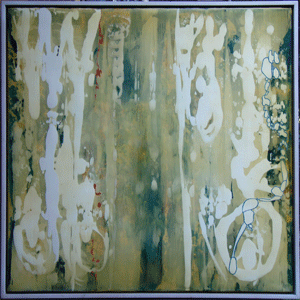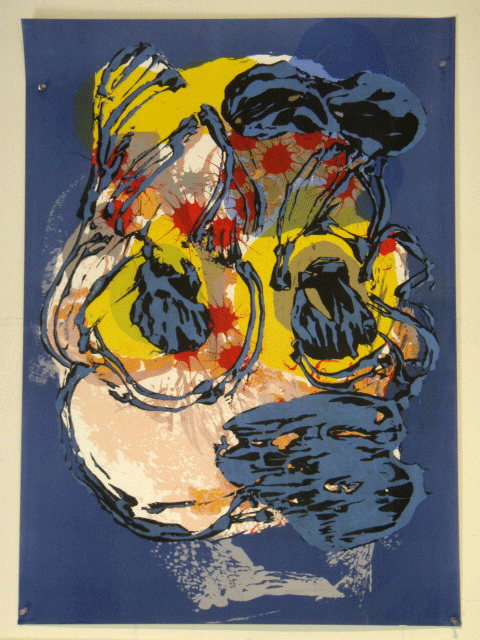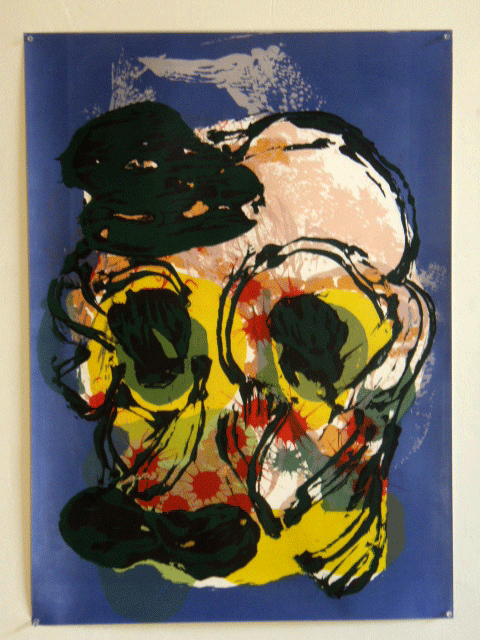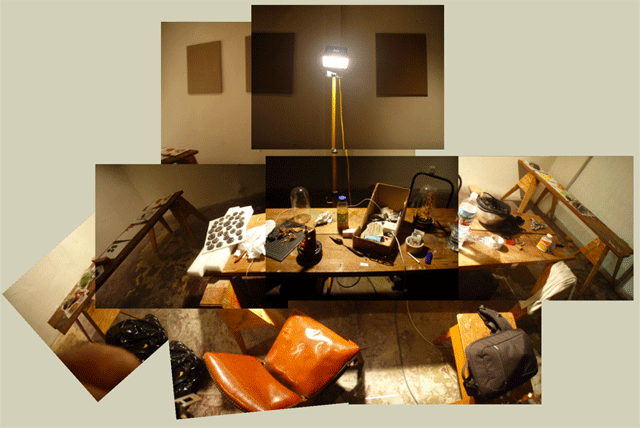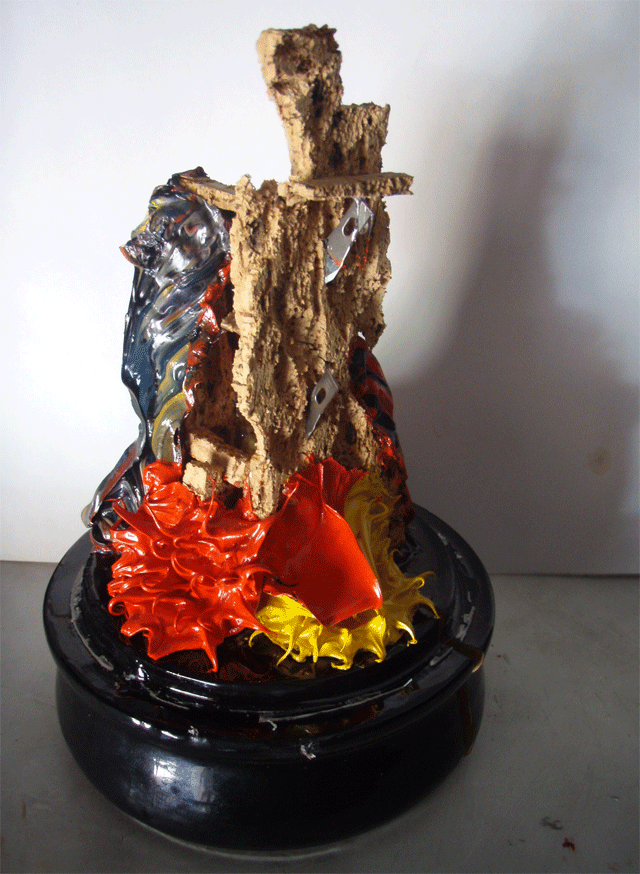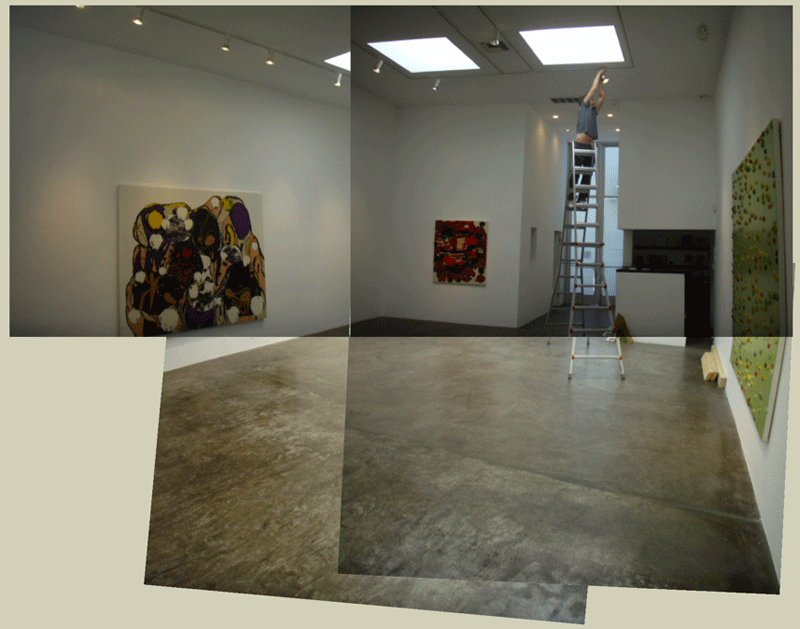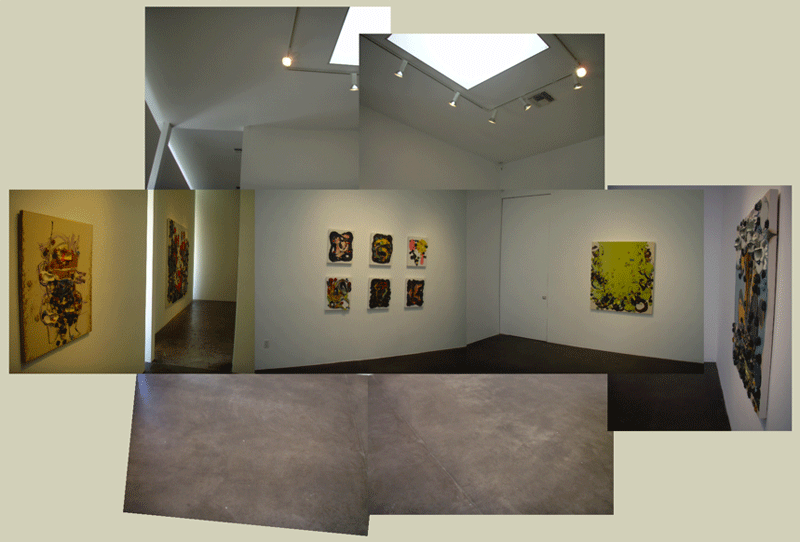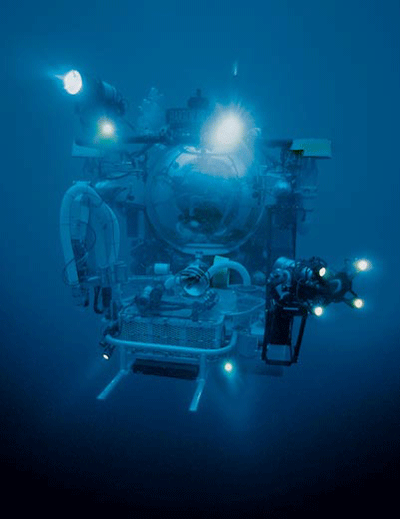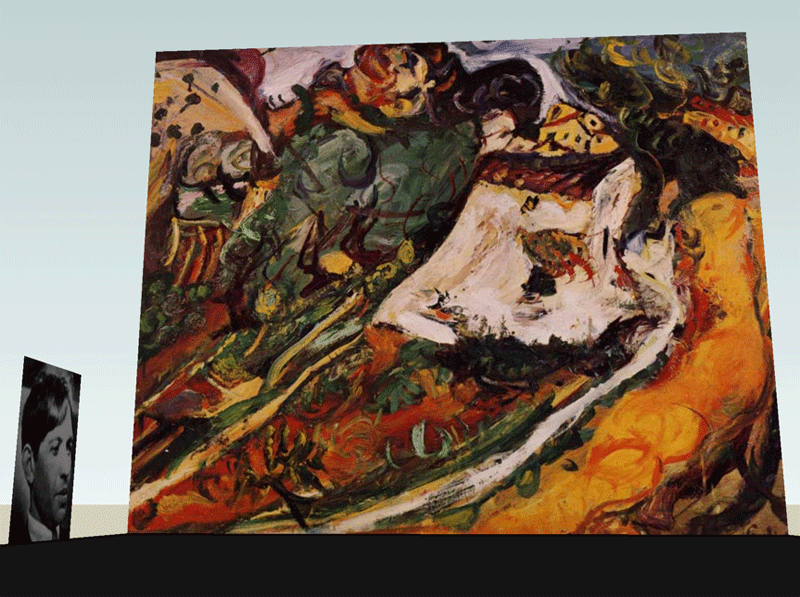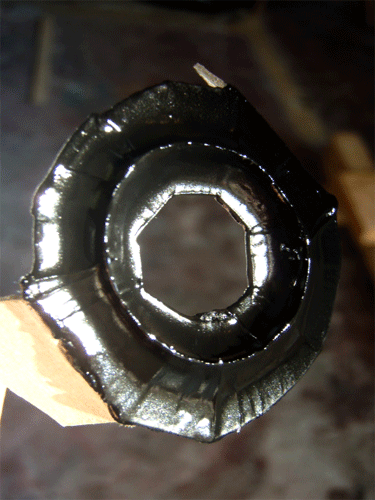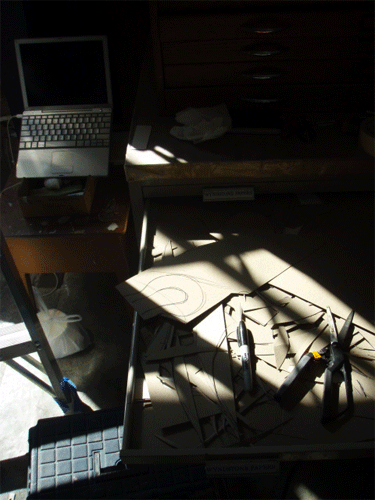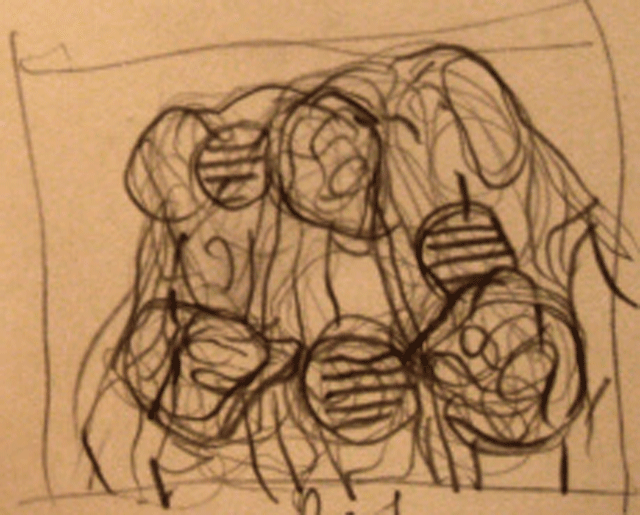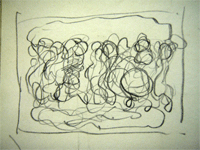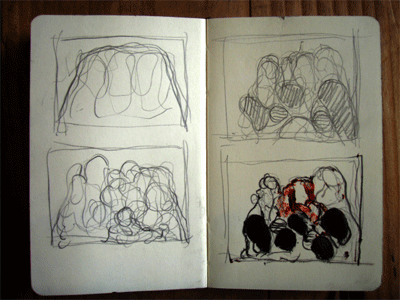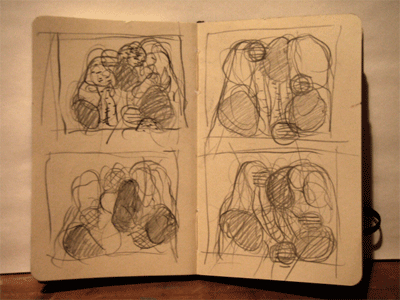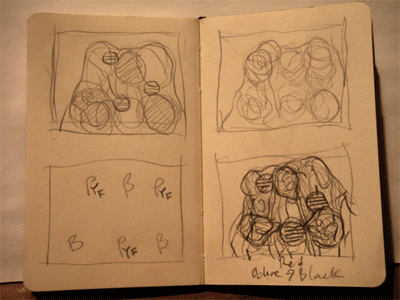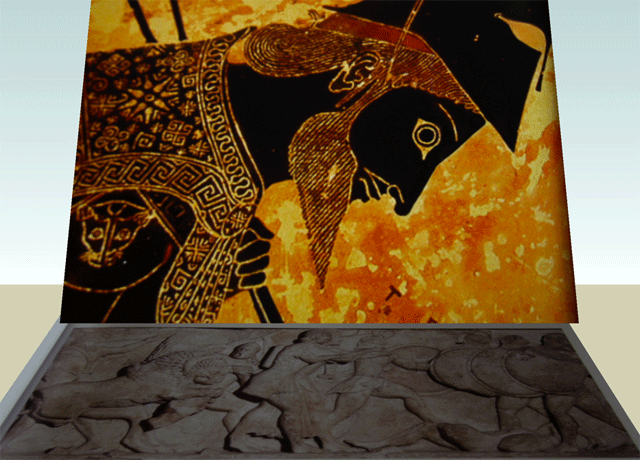April 29, 2008
(Emphasis Mine)
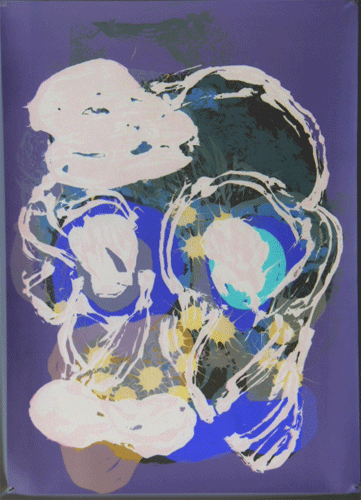
This edition of (Emphasis Mine) grew a bit larger, so much more than the front of this blogpost should handle, so here is instead an image that I wanted to see, one of the George Page prints inverted so I can see what might happen if the black plate is printed in white or some such lighter tonality instead.
A traditional program in studio art typically begins with a course in drawing, where students are introduced to the basics of line, form and tone. Life drawing is fundamental to this process, not only because of the complexity of the human form (that limber scaffolding of struts and masses) but because it is the object for which we have the most familiarity -- and sympathy. Students invariably bristle at the drawing requirement, wishing to vault ahead to the stage where they make "real art," but in my experience, students who skip the drawing stages do not have the same visual acuity, and the ability to see where a good idea might be made better.Isn't the idea to celebrate by negating or transgression? To break the egg? " As what is becoming my habit, I took the opportunity to explore the characteristic working methods of my compatriots, to see if I can find a way to "break the egg" (a phrase we used by Henry and I when we critiqued Alberto's recent work talking about the need to overcome one's p.o.v. in order to grow into a new one)."Following this introduction, students might specialize in painting, sculpture or such newer media as photography or video. A rigorous college art program provides a strong vertical structure, so that students take a sequence of ever more challenging courses in the same medium. Most undergraduate programs culminate in a senior show, a high-spirited and uneven romp in which students' clever ideas race far ahead of their execution and workmanship. It was for just such a show that Ms. Shvarts's project was, so to speak, conceived.
It is often said that great achievement requires in one's formative years two teachers: a stern taskmaster who teaches the rules and an inspirational guru who teaches one to break the rules. But they must come in that order. Childhood training in Bach can prepare one to play free jazz and ballet instruction can prepare one to be a modern dancer, but it does not work the other way around. One cannot be liberated from fetters one has never worn; all one can do is to make pastiches of the liberations of others. And such seems to be the case with Ms. Shvarts.
* * *
In "My Life Among the Deathworks," the sociologist Philip Rieff coined the term "deathworks" to describe works of art that celebrated creative destruction, and which posed "an all-out assault upon something vital to the established culture." He argued that the principal artistic achievements of the 20th century were such deathworks, which, however lovely or brilliant, served primarily to negate or transgress the existing culture, rather than to affirm or celebrate it. He did not live to see Ms. Shvarts's piece, but one suspects that he would have had much to say.
Mr. Rieff was especially interested in those who treated their bodies as an instrument of art, especially those who used them in masochistic or repugnant ways. By now, it is hardly an innovation to do so. Nearly two generations have passed since Chris Burden had a bullet fired into his body. It is even longer since the Italian artist Piero Manzoni sold tin cans charmingly labeled Merde d'artista, which contained exactly that. Even Ms. Shvarts's central proposition -- that the discomfort we feel at the word miscarriage is itself a species of linguistic oppression -- is a relic of the highly politicized literary theory of the late 1980s.Chris Burden's bullet to the arm is an excellent example. His early work served an artworld narrative that was successfully embodied in BCAM. Burden's later career could not develop that narrative any further. Instead he became known via his work as a sheer force of personality rather than the iconoclastic bull in the performance/conceptual China shop. Still a bull he is to be sure, but it is no longer the same ring positioned by the dialog twenty to thirty years ago.
What has not been widely recognized is that the Ayatollah Khomeini?s 1989 fatwa against Satanic Verses author Salman Rushdie introduced a new kind of jihad. Instead of assaulting Western ships or buildings, Kho? meini took aim at a fundamental Western freedom: freedom of speech. In recent years, other Islamists have joined this crusade, seeking to undermine Western societies? basic liberties and extend sharia within those societies.The cultural jihadists have enjoyed disturbing success. Two events in particular?the 2004 assassination in Amsterdam of Theo van Gogh in retaliation for his film about Islam?s oppression of women, and the global wave of riots, murders, and vandalism that followed a Danish newspaper?s 2005 publication of cartoons satirizing Mohammed?have had a massive ripple effect throughout the West. Motivated variously, and doubtless sometimes simultaneously, by fear, misguided sympathy, and multicultural ideology?which teaches us to belittle our freedoms and to genuflect to non-Western cultures, however repressive?people at every level of Western society, but especially elites, have allowed concerns about what fundamentalist Muslims will feel, think, or do to influence their actions and expressions. These Westerners have begun, in other words, to internalize the strictures of sharia, and thus implicitly to accept the deferential status of dhimmis?infidels living in Muslim societies.
Call it a cultural surrender. The House of War is slowly?or not so slowly, in Europe?s case?being absorbed into the House of Submission.
Michael?s RealismI think of this article in terms of mapping a similar divide in our artworld: between conceptual (Tom) and material (Sonny), between the deskillers normally found in grad schools; and the skillers in undergrad schools; between the marketplace and theory. Michael's Realism in this respect would be a rejection of one-instead-of-the-other and a choice of what was referred to in the article as a "toolbox": "Michael relinquishes the mechanistic, one-trick-pony policy approaches of his brothers in favor of a ?toolbox,? in which soft and hard power are used in flexible combinations and as circumstances dictate. ". Therefore, instead of rejecting conceptuality wholesale, better to embrace an expansion of conceptuality and steer away from sound bites and simplistic intellectual reductions. Instead of the crude brute facts of (mediated?) materiality, let's seek instead material nuance and subtlety. More information per cubic inch. The embrace of Both/And instead of Either/Or directs us towards suppleness in "flexible combinations and as circumstances dictate", "finding theory in skills, finding skills in theory".THE STRATEGY that ultimately saves the Corleone family from the Sollozzo threat and equips it for coping with multipolarity comes from Michael, the youngest and least experienced of the don?s sons. Unlike Tom, whose labors as family lawyer have produced an exaggerated devotion to negotiation, and Sonny, whose position as untested heir apparent has produced a zeal for utilizing the family arsenal, Michael has no formulaic fixation on a particular policy instrument. Instead, his overriding goal is to protect the family?s interests and save it from impending ruin by any and all means necessary. In today?s foreign-policy terminology, Michael is a realist.
Viewing the world through untinted lenses, he sees that the age of dominance the family enjoyed for so long under his father is ending. Alone among the three brothers, Michael senses that a shift is underway toward a more diffuse power arrangement, in which multiple power centers will jockey for position and influence. To survive and succeed in this new environment, Michael knows the family will have to adapt...
...For all his talk about diplomacy, Tom believes in the family?s dominance; like today?s liberal institutionalists, he assumes that allies will continue to pay fealty to the family as a matter of course, as they have in the past. Similarly, Sonny assumes that other powers will gravitate toward the family or risk irrelevance; like most neocons, he sees allies as essentially disposable. By contrast, Michael intuitively grasps the value of family friends and the role that reciprocity plays in retaining their support for future crises. Thus, he is seen offering encouragement and a cigarette to Enzo, the timid neighborhood baker, whose help he enlisted to protect his father at the hospital. In this, he is imitating his father, Vito, who saw alliances as the true foundation of Corleone power and was mindful of the need to tend the family?s ?base? of support, not only with big players like Clemenza and Tessio (Britain and France) but with small players like the cake maker and undertaker (Poland and Romania), whose loyalty he is seen cultivating in the opening scenes of the movie. As Michael knows, even small allies could potentially prove crucial in ?tipping the scales? to the family?s advantage, as they will for America, once multipolarity is in full swing. Relearning the lost Sicilian art of alliance management will be necessary if Washington is to regain the confidence of the growing list of allies whose blood and treasure were frittered away, with little or nothing to show in return, in the sands of Iraq.
4. (A very interesting New Yorker article by Jerry Saltz)
Each on his own is good at this mannered nonstyle. But their show, while roguish, is merely occupying a well-defined position. A heat-seeking art world, mindlessly drawn to the familiar, has deemed that current art should look this way, so more art does. That?s part of the bad thing.Of course, I see familiar themes here of death and musical chairs.Like so many recent exhibitions (numbing swaths of the Whitney Biennial, portions of the New Museum?s ?Unmonumental?) the Colen-Lowman outing resembles a disheveled rec room. The palette du jour in these shows is black-and-white, black-and-silver, monochrome, Day-Glo, or printer?s colors like magenta and cyan applied mechanically or in intentionally messy ways. Posters, gaffer?s tape, magazine pages, and found objects are placed about. Images are usually derived from newspapers, ads, or porn. Text and jokes often appear (? la Richard Prince); holes are often bashed in walls; Sheetrock and plywood are broken up and spray painted. Noland?s ideas about sculpture and Prince?s about appropriation are so prevalent that those artists ought to be drawing royalties.
Much of this work takes visual cues from the photographs that appeared in art magazines of the sixties and seventies, translating that smudgy halftone quality to three dimensions. These artists seem to want to crawl into the skins of Gordon Matta-Clark and Robert Smithson, whose work did intrusive things to the large and familiar, and a preapproved roster from the so-called ?greatest generation.? It?s a cool school based on an older cool school, and it gains attention the way a child of a celebrity does. Many artists of this stripe went to art school and have apparently internalized the beliefs of their teachers, using strategies common when those instructors were young. They?re making art in ways that their teachers thought art should be made. This is an Oedipal-aesthetic feedback loop, a death wish. Some of this art is good. Most of it already looks very dated, or will soon.
April 28, 2008
(Emphasis Mine)
Three items in the recent news. Art and Life Death:
An exhibition to die for?literally
Gareth Harris | 17.4.08 | Issue 190LONDON. The German artist Gregor Schneider is planning the ultimate performance piece: showing a person dying as part of an exhibition.
Advert
?I want to display a person dying naturally in the piece or somebody who has just died,? he told The Art Newspaper. ?My aim is to show the beauty of death.?The artist says that Dr Roswitha Franziska Vandieken, who runs her own private clinic in D?sseldorf, has agreed to help find volunteers who are willing to die in public in the name of art. Dr Vandieken was unavailable for comment. ?I am confident that we?ll find people to take part,? says Schneider.
He says he would like to stage the performance at the Haus Lange museum in Krefeld, Germany. The museum declined to comment.
The Costa Rican artist Guillermo Vargas, also known as Habacuc, is surrounded in a great controversy due to the death of a street dog in an exhibition that was created last August in Managua (Nicaragua).Several defenders of the animals in Costa Rica discovered this work through blogs and accused it yesterday of cruelty.
In this exhibition, the artist confronted the audience with an emaciated, ill street dog, hungry and tied to the corner of the room.The animal was captured in a poor district of Managua. The dog died after a day in the exhibition, according to the Nation.com Marta Leonor Gonz?lez, publisher of the cultural supplement of the Press in Nicaragua. The installation also included the phrase, written with dog food, "You are what you read"; as well as of an audio of the Sandinista Hymn "The Other Way Around", photos and a incense burner, where 175 stones of crack and one ounce of marijuana were burned. Habacuc said yesterday that its work went a tribute to Natividad Canda, Nicaraguan that died after being attacked by two dogs to rottweiler in a factory in Carthage.
Art major Aliza Shvarts ?08 wants to make a statement.Beginning next Tuesday, Shvarts will be displaying her senior art project, a documentation of a nine-month process during which she artificially inseminated herself ?as often as possible? while periodically taking abortifacient drugs to induce miscarriages. Her exhibition will feature video recordings of these forced miscarriages as well as preserved collections of the blood from the process.
The goal in creating the art exhibition, Shvarts said, was to spark conversation and debate on the relationship between art and the human body.
Posted by Dennis at 10:53 AM | Comments (0)
April 25, 2008
PruessPress Spring 2008
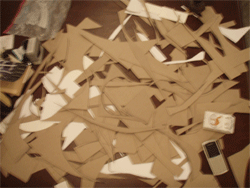
Andrew Hahn is the captain of the PruessPress ship in LA (Owner Joel Mesler has branched out to New York where he has a press over there and a gallery called Rental Gallery). We've been talking about doing something with the press and now that the show at Michael's is up and before I wheel into a new group of paintings, this is a perfect moment to tip the bucket and see what we can do together.

(Image above from the blogpost: Toolz)
Andrew asked if I could use my shards in a print. Immediately I thought of the pile of cardboard shards I had in the studio. I liked the idea of using the cast offs from the process of creating the fractal lines that inform most of my paintings. Andrew was thinking of the fractal lines rendered from shaped cardboard and I was thinking of the use of the cast offs, the shards that possess a reflection of information that created the lines in the paintings. I was excited about the shards and Andrew was excited about the fractal lines and how the print machine would render them.
We did both.

The general agenda was to start in the afternoon and see what we have there at PruessPress, what kind of ink is on hand, what kind of paper that we will be dealing with. All expectations were suspended.
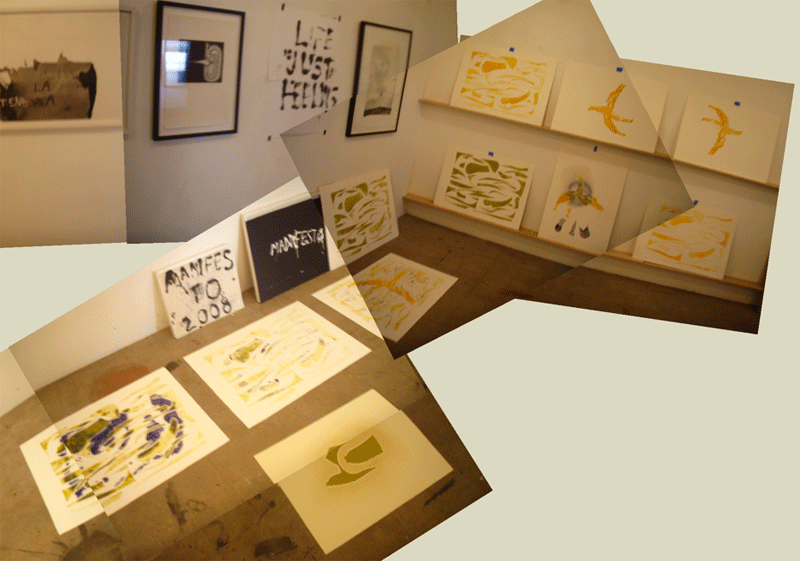
What occurred to me was how different each and every print house is, how the character of each delivers different possibilities, how much fun it is to generate different bodies of work at each location and how specific the print editions are to the character of the person who created each establishment.
Imagine our delight when we ended the afternoon generating the beginning of an edition of ten, grouped in pairs, five different arguments in ink and paper. New projects suggested themselves along the way. This was just a beginning, maybe four or six sessions will finish the edition. The day had the ring of a well driven nail into douglas fir.
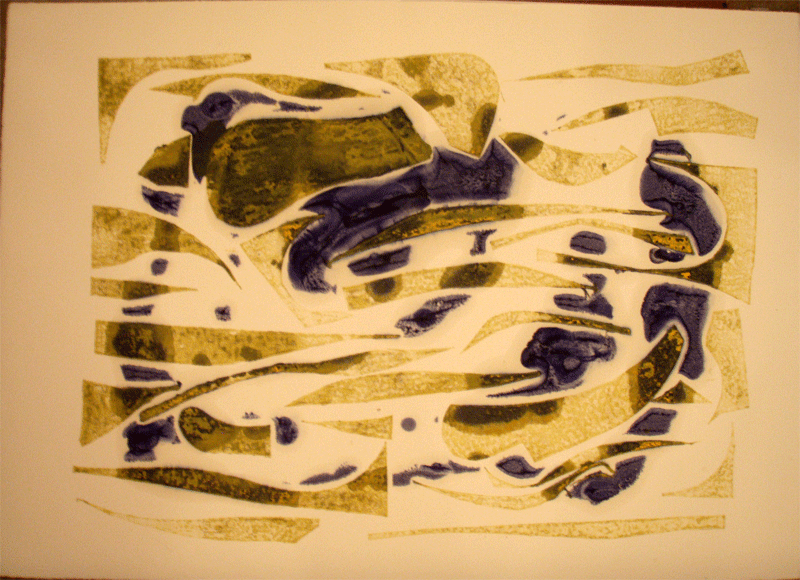
Peering Through My Fingers
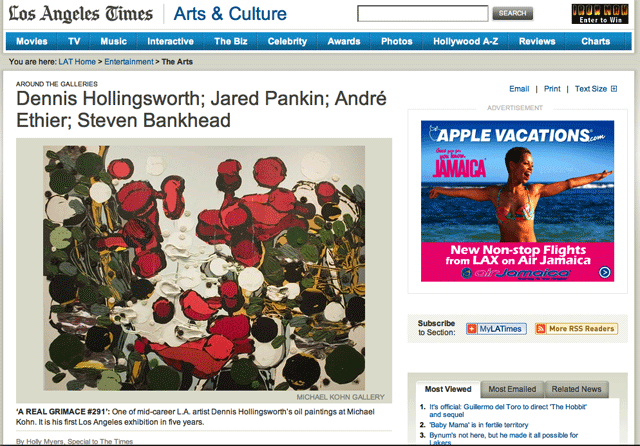
I'd like to make a t-shirt with the last paragraph.
AROUND THE GALLERIES
Dennis Hollingsworth; Jared Pankin; Andr? Ethier; Steven BankheadMICHAEL KOHN GALLERY
?A REAL GRIMACE #291?: One of mid-career L.A. artist Dennis Hollingsworth?s oil paintings at Michael Kohn. It is his first Los Angeles exhibition in five years.By Holly Myers, Special to The Times
April 25, 2008It's difficult, at first, to pinpoint just what makes a room full of Dennis Hollingsworth's paintings so very intoxicating, but it surely has something to do with the smell of oil paint. Lots of it. Handfuls at a time, applied in dollops and smeared across the surface of the canvas, or slathered in sheets like glistening slices of prosciutto, or shaped into tight, prickly mounds resembling the shells of chestnuts.
The paint -- presumably dry, but only recently so -- fills the room with a lush, heady scent that seems to seep into one's very pores, enveloping the viewer in the work's exceptionally visceral presence.
The effect, though largely incidental, is a fitting prelude to the many more concerted seductions contained in Hollingsworth's current exhibition at the Michael Kohn Gallery, his first in Los Angeles in five years. There are 13 paintings in the show, ranging from 20 by 16 inches to 9 feet across. Each sports luxurious, almost decadent (but never quite gaudy) quantities of pigment, manipulated with supreme confidence and skill.
The forms are abstract but made, in large part, from a limited range of specific gestures, each with its own sculptural identity: the push-and-smear, the palette-knife slather, the spiky daub, the loose swirl of multiple colors. Each composition has the feel of a self-contained ecosystem, with these gestures interacting like so many individual species, the whole governed by a sense of organic, if somewhat chaotic, logic.
The twists and turns of the pigment itself -- the glossy ridges, gouged furrows, smooth planes and prickly briars -- are endlessly absorbing: liable to draw a viewer to within a foot of the canvas and to tug the eye through a long series of close-range excursions, especially in the case of the larger works. Step back, however, and it's clear that these details acquire their power from a formidable structural integrity.
The spontaneous clusters of small blots that hold one's attention in the short term cleave barnacle-like to slower, heavier forms that keep the compositions firmly grounded. Seemingly decorative details are swept up in grander architectural gestures. Patches of dense, frenetic activity open up to broad swaths of negative space that lend each composition the balance and stability of a landscape.
Los Angeles has an unfortunate history of neglecting its midcareer artists, whether by ignoring them altogether in the glare of each year's graduating class or by failing to provide the opportunities (and respect) they receive from institutions in Europe and elsewhere. As a result, entire generations of L.A. art are going unseen on their home turf, the influence of these artists under-acknowledged except by their students and peers. This exhibition -- only the seventh of Hollingsworth's 35 solo shows to be held in L.A. -- is a prime example of what the city stands to lose in such a bargain: artists of proven commitment and consummate skill, whose work shapes the identity of L.A. art for much of the rest of the world.
Michael Kohn Gallery, 8071 Beverly Blvd., Los Angeles, (323) 658-8088, through May 31. Closed Sundays and Mondays. www.kohngallery.com
*
*
*
Look at the ground.
Kick a rock.
Back in the Day: 1992-3
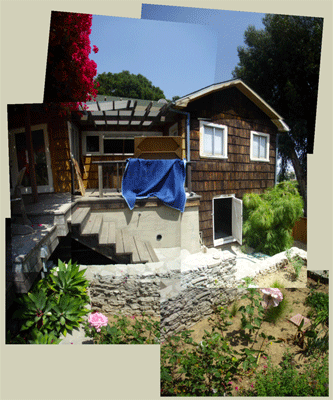
We're having termite treatment done to the house and the service guy told me that he wanted to get underneath a pile of paintings that I had stacked in a corner below the house. Cool. I wanted to clean off the cobwebs and repack them anyway. Along the way, I can post this blog entry to document a brace of paintings that I had made a couple of years out of grad school.
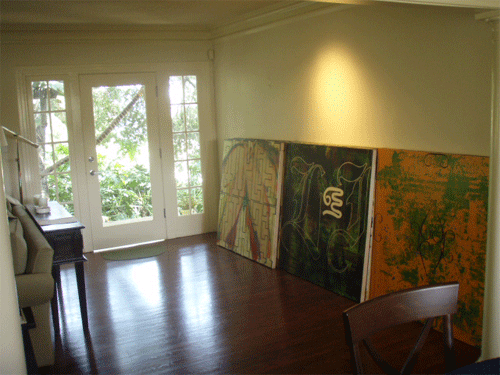
Let's take a closer look at them...
(BLOGPOST IN PROGRESS)
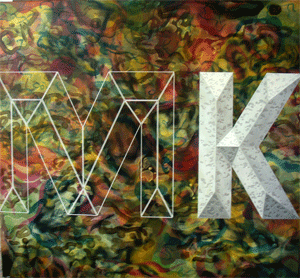
The story behind these paintings goes like this:
I like to say that to be an artist is to recognize one's affinities and make them vivid for others. That's fine as far as art in the broadest aspect but even though there are many art worlds, there is also a specific art world identified by a relation to a dialog, an entity which many in the art world take to be singular and known but most times it is multiple and contested. My affinities settled on painting long ago. I was a kid of about fourteen when I stood in front of Goya's "Saturn Devouring His Children" in the Prado, my mind dilating with lumps of paint and pain.

Grad schools generally do a good job in initiating folks into the labyrinth that is our international art dialog. During 1989 to 1992, the dialog... can best summed up by what came to be the Eli Broad Collection. It's a summary of art in the postmodern era and it appeared to me that the dialog had reached its' apotheosis when it embraced death: the death of the author, the death of painting. I don't want to write a book about it (yet), so the best summary I can offer is in the blogpost Be Mistrustful of History:
Instead of touching G-d through material means, they endevored to touch everyday life through conceptual means.I love the Lawrence Weiner quote: "We had to question the answers given to us in school." Artists at the end of the fifties and the beginning of the sixties questioned the answer of high modernism and flipped it on its head. A true revolution, Coprenican, like the invention of zero or negative integers. A cone of innovation reached an apotheosis and disappeared at its zenith. And what appeared was a raging mountain stream, a torrent of innovation that prized the conceptual over the material. Pop was followed by the Minimal, followed by the Conceptual, followed by Theory. The fruit of the postmodern tree was the conceptual, to be sure (Sol LeWitt, as far as I'm concerned). Art had to be dematerialized. It had to be in its essence, an idea. The stream flowed and broadened over time into a grand and stately river, soon into a slow and wide delta. That is where we are now: silted, fetid, and oozing out to sea, to be evaporated into oceanic clouds, ferried along the winds to mist the mountaintops.
Once again.
And what of painting? Implicated by its materiality, dammed as the ultimate patriarch of art, painting had to play the fool to get along after the inversion of the pyramid/cone, the revolution. Painting had to decry itself: bad painting, the Homer Simpson guise, the anti-aesthetic, the turn of the volume of paint to zero, the monochrome, reductions of all sorts, the subordination of paint to other art forms (photography, for instance). To be a painter in the thirty years before the 90's, one had to hide the paint in one way or the other, one had to paint in alienation.
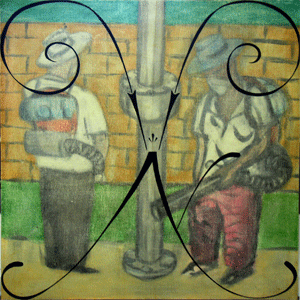
The underlying philosophical implication was a contest between free will and determinism. The revolution of 1968 took refuge in the latter in order to deliver the "better" world it was seeking, blinded by zeal to the dangers of totalitarian abyss. The transgressive mandate of Western art was becoming scumbled into a nihilistic embrace of death, something I tried to address in Personal, Difficult Things. A counter revolution compelled the rejection of death. The blur of the line that divides the imagination and reality spawned suicidal tendencies as an emergent phenomenon. As the popular expression goes: no harm, no foul. Is this true for our art world any more? The visual arts has long enjoyed this special license, something the design arts has not been able to share. I'm thinking of the case of architecture, where there exists a professional mandate identical to that of physicians to do no harm. Designing a building that will collapse and kill its' occupants is contemplated not even for a millisecond. Death is a no-go, especially when it become vividly possible. But now I have begun to wonder about this special artistic license of ours.
We must become the moth that knows the flame will kill.
Against the utopian impulse that provokes determinism, civilization requires that free will must prevail. Freedom and individualism and dissent. This is, it seems to me, the very soul of art. Without this, art itself -our dialog- would die.
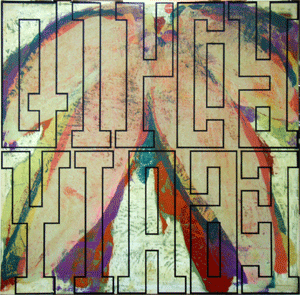
The postmodern epoch had reached a fullness and the next era won't be born until those who are involved in the dialog begin an exhaustive auto-critique. The song for musical chairs was playing and no one was willing to get out of their seats... I guess that's natural but even the fall of the Berlin wall wasn't enough to provoke an epochal self examination. Violins and burning cities. As the next decade and the next pretended that a postmodernity that bloomed from 1950 to 2010(?) would be good enough for the century to come. This, I found doubtful.
I didn't think that it would be interesting or desirable to add another brick to that overdetermined edifice.

I wanted to paint instead, in affirmation.
The question was how to start.

I started with a sandwich. I wanted to sandwich a background painting with a foreground painting. In this way, I could paint anything that caught my eye, I could range. And later I could close the painting by striking a foreground like a cancelled stamp in the post office.
A battery. Two things become more than a third. Such a strategy was in the Ed Ruscha universe when the foreground was a barrier to the background. A gate or fence barring the way to the Eden of unselfconscious painting. Ed Ruscha, the postmodern figurehead for the West Coast. But what if you run the Ruscha program in reverse? What if the foreground began to merge with the background? A chameleon. Sympatico aesthetics.
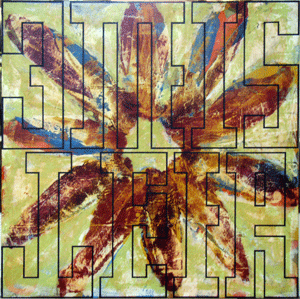
I worked in what I call a full spectrum Darwinian mode. Most people know about "Survival of the Fittest", natural selection in a time of scarcity. But how is it that we tend to ignore the compliment: a proliferation of types in a time of plenty? Therefore I proliferated types and selected the best from them, cycling braces of work and streaming definitive simultaneous lines of inquiry:
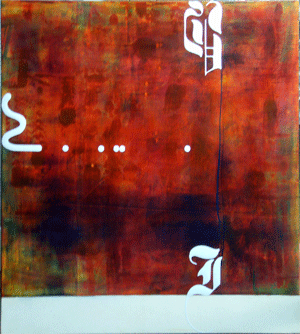
Detail.
-"Glaze Paintings" made from successive coats of transparent alkyd glazes. Puddles of colored jellied glaze were dropped onto the canvas, the slender finger of paint in free fall became a different kind of drawing implement. Drawings. A drywall knife flattened the alkyd mass. Drawing and erasing. Early stencils (they were less like stencils in the repeatable aspect of stenciling than the unique technique delivered by custom friskets, which is what I was doing... it's just that the term "stencil" seems more handy than the term "frisket") emphasized the barrier of foreground versus background like prison bars. Later foreground stencils mapped the substrate in a way that reminded me of my time in the Navy, those years in Combat Information Center.
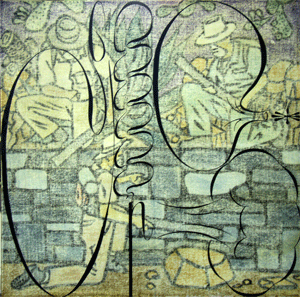
-"Leaf Blower Paintings" where conventional figure paintings using the ubiquitous leaf blower worker (allowing me to pay homage to Diego Rivera -we traveled to his home town in Guanajuato back in '88) was scrubbed and sanded down, the paint back into the weave of the canvas, perhaps erasing na?vet? from simplistic figuration. The final element of the sandwich began to emulate the pneumatic action of the man/machine.
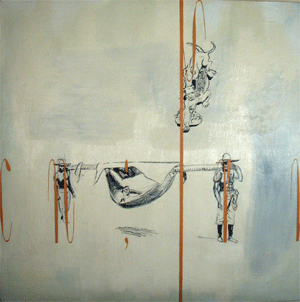
Detail.
-"Wet into Wet paintings" where as I applied a wet brush into wet paint, I realized that there was something special going on. A loaded brush, a loaded support, a loaded subject... the brush spent itself with the turns of fingers, wrist, arm and body into the bed of paint as I chased a representational objective. I wiped the brush and loaded it again and swept back into the liquid field. All mistakes could be swept away by scrubbing the field for a fresh start, even or especially as I measured success by the proximity of (representational) failure. The ability to fail was a perfect counter to the self assured fabrication of media and conceptualization so championed by the authorities of grad school.
The wet into wet approach was so special to me that it took all my attention and obliterated the simultaneous multiple aspect of my studio practice. This particular painting (above) is the one where I realized that the wet into wet approach had to jettison the sandwich strategy. I had to develop this kind of painting on its own terms.
So, back in the day, as '94 turned into '95, I sat down to work out just what this special quality was that the wet into wet technique implied.
(BLOGPOST IN PROGRESS)
April 22, 2008
George Page
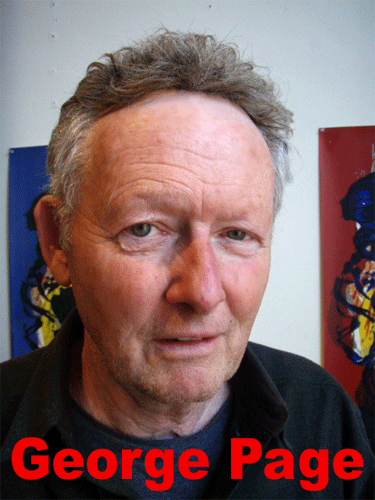
George Page called earlier in the year asking if I was interested in making another print project, and I said sure. George is supercool, a master printer for Sam Francis at the famed Litho Shop in Santa Monica, he now has a home and studio in two separate structures out in that part of the California desert where David Hockney snapped his Pearl Blossom Highway.
He dropped off eight mylars and suggested that I paint on them as I would on any canvas, in the colors I would like to see in the print. I was swamped with the painting for the recent show, and it was weird making marks on the mylar where one couldn't see a final composite result for a stretch of time to come. Distended causal chains of daub and effect. Make a mark and wait two months to see what it looks like. After a while I was barely hanging in there, holding onto some abstraction of an expectation of what's to come as I clumsily touched paint to the unfamiliar mylar surfaces.
So today he had under his arm, a role of fourteen initial proofs on cheap paper so we can see what happened when he ran the burned plates and plied them into variations. Leave them on the wall for a while and see what you think.
A ver...
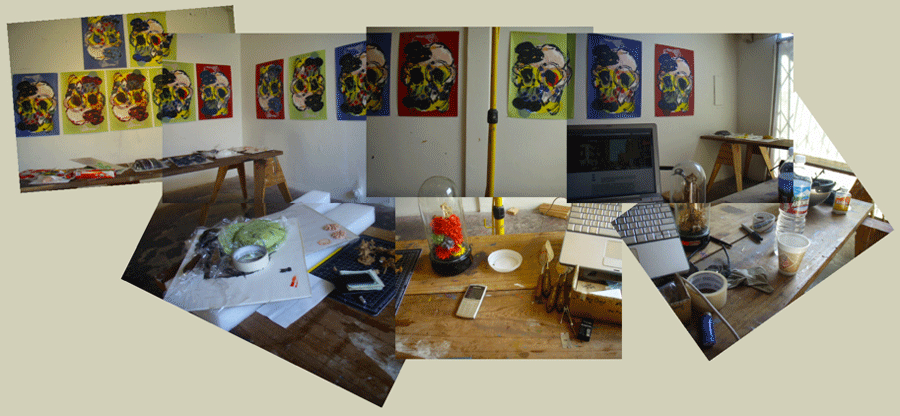
Skulls. I see skulls via the camera, more so than en vivo. Facing. Face to face, they tend to look to me like clowns, a white hat on a white painted pate... but the lips aren't red. Funny, the difference between a camera lens and an eye.
I relied on the schema of face, of portraiture as an armature to congeal various ways of touch paint to canvas mylar. Certainly two big dabs in the center midline of the picture plane is plenty to hang a face on. A compass rose: portrait, landscape, still life, figures can be another north, south, east, west. One could sail north by northwest for example. Or maybe one might find a 33? 56' North, 118? 24' West in transposed visual/painterly terms..
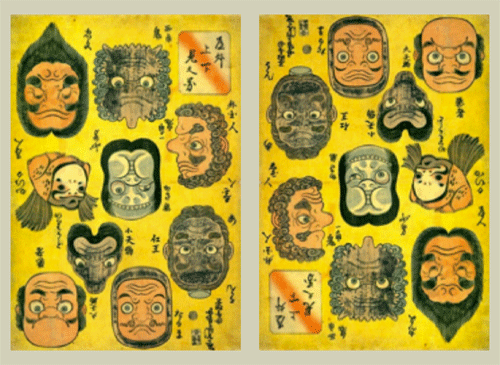
I came across these Japanese flip images via Boing Boing.
Joge-e, or ?two-way pictures,? are a type of woodblock print that can be viewed either rightside-up or upside-down. Large numbers of these playful prints were produced for mass consumption in the 19th century, and they commonly featured bizarre faces of deities, monsters or historical figures (including some from China). Only a few examples of original joge-e survive today.
I was thinking of how these mylar layers can cohere into a face... and how we could shuffle them away from face, a flip of each layer into new combinations. Color, too. Permutations.
Here's a closer look:
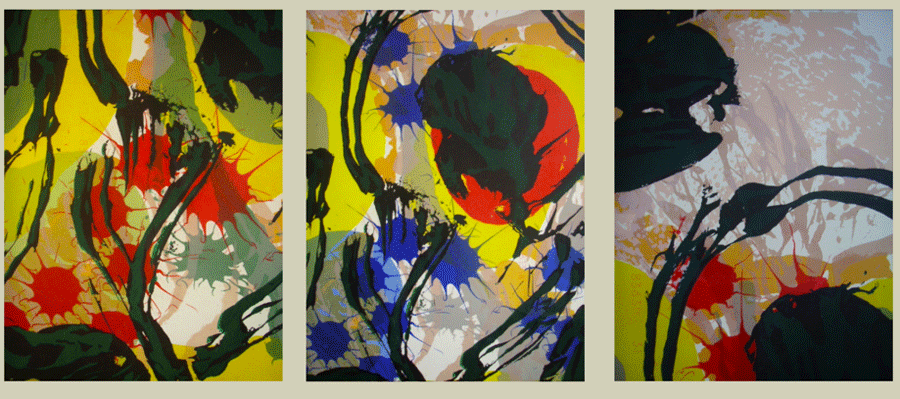
I was painting the mylars, aware that the only aspect that would transmit to the press was the silhouette of the solitary painted mark.
So strange.
Then I looked at them again and thought: B?tzer. I'm doing an Andreas B?tzer.
Wow.
Cool.
April 21, 2008
What's a Sophic Hydrolith?
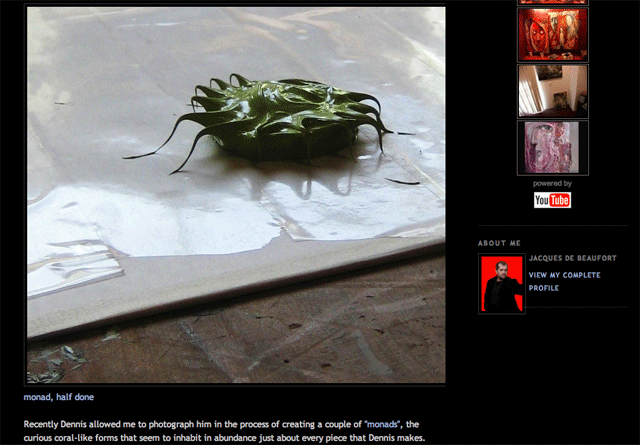
Jacques de Beaufort and I hit the local coffee shop the other day, talking about monads and the problem of the subjective/objective split, the world of the imagination and the world we all share between us. He told me he was cooking up a blogpost about this topic and lo, check it out.
Oh yea, and a Sophic Hydrolith? It's a Philosopher's Stone.
Bart Exposito
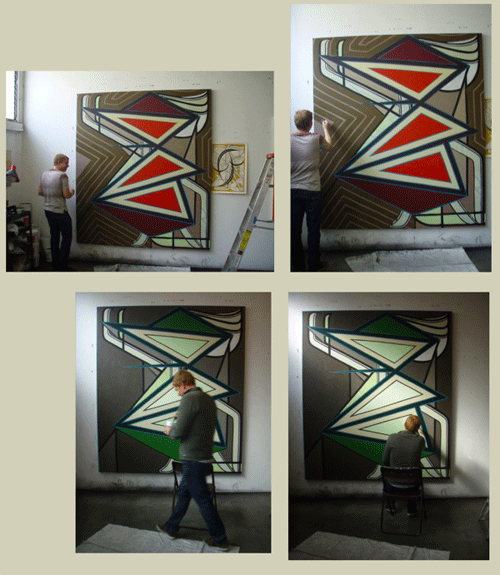
These two sets of pictures are about a week apart, the upper ones are the earlier ones. Here, you can see how Bart composes and edits his work, honing color all the while.
A Few Opening Shots

I spent the entire opening in the smile-meet-greet mode, my camera squeezed not as consistently as I perhaps should have done. Here are a few shots that might impart a bit of the flavor of the evening.
Here's an enlargement:
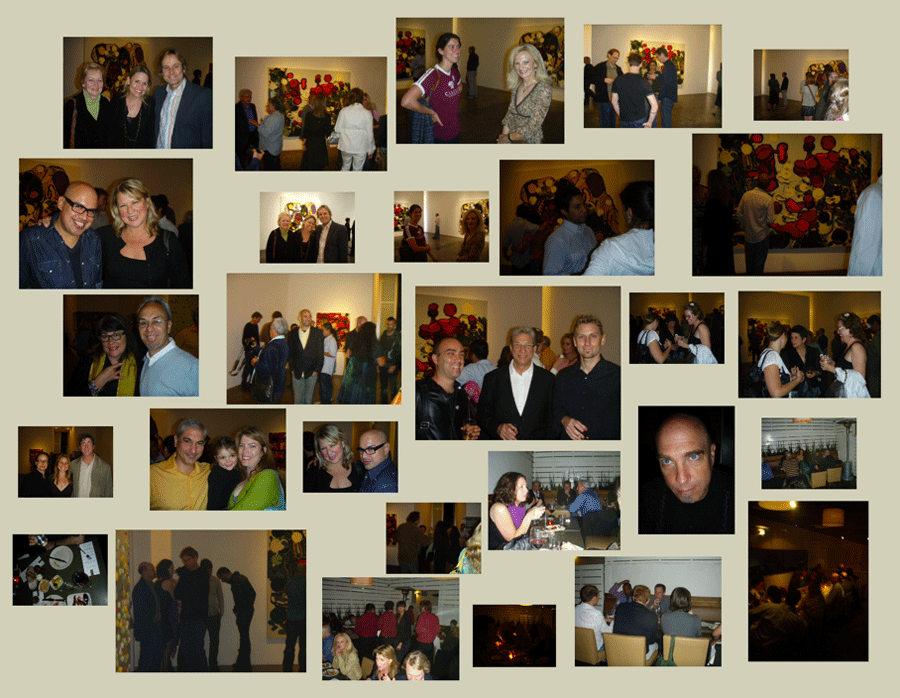
April 19, 2008
Ahora
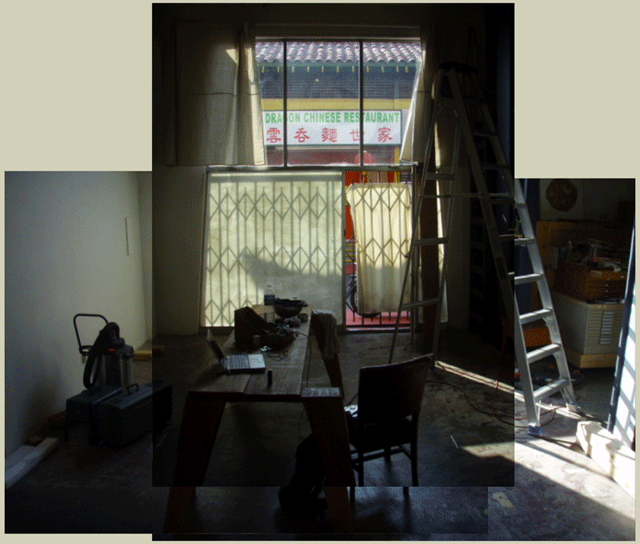
First item on the agenda: FORM AN AGENDA.
But not today.
(Admin: I'll be backfilling the past two entries with fotos, stay tuned...)
April 18, 2008
Ahora

A little gardening before the opening. Nothing like some dirt under your fingers before the ego bomb hits.
A little closer:
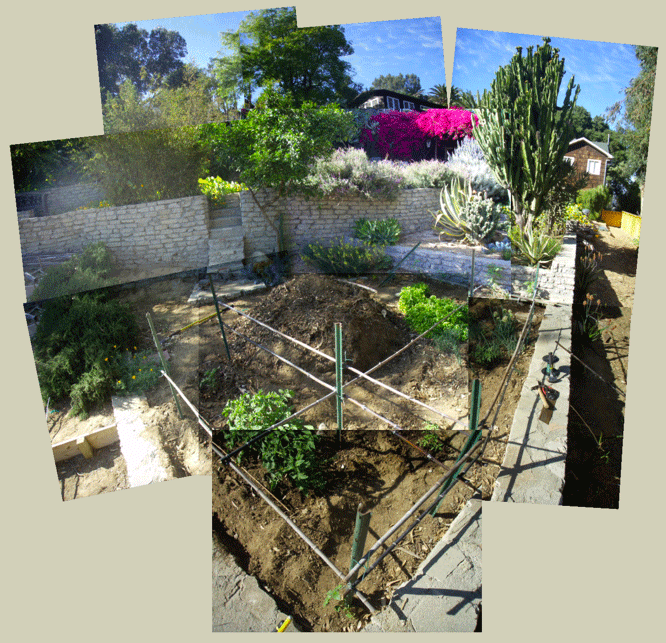
April 17, 2008
The Pick Up

The folks at LA Packing and Crating sent Eric and Rich to haul the work to the gallery. Art handling companies are roughly the same, owned and run by late to middle aged pony tailed dudes and a legion of artists under them who need some kind of work that will let them make art when they get home.
Eric is an artist and Rich is a musician. Rich's band is called Very Be Careful, Columbian/Puerto Rican cumbia-like music. I jumped on iTunes and bought a few songs, supercool.
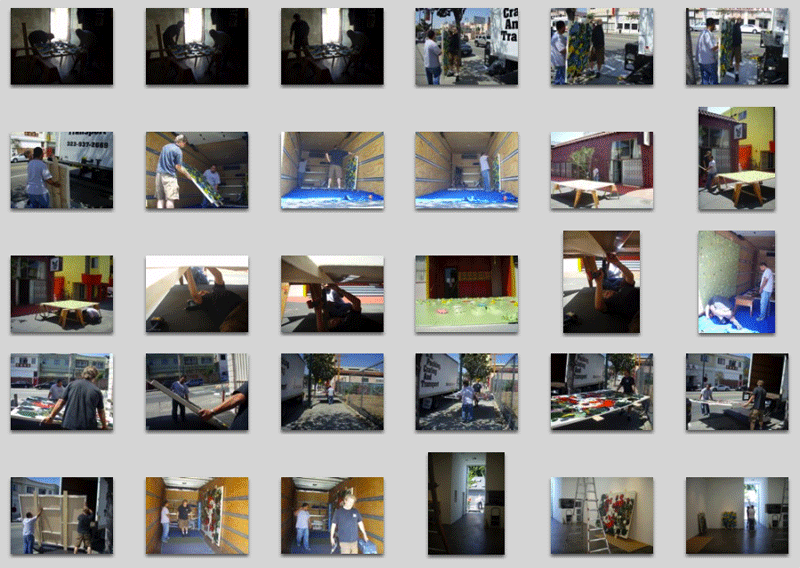
April 16, 2008
A Nonpolar Art Universe
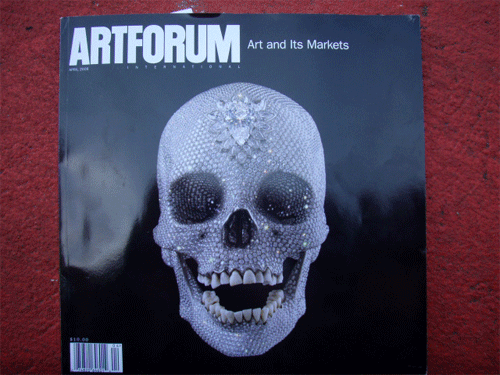
My gallery here in Los Angeles, Michael Kohn Gallery, has an ad out for our show in this month's ArtForum. Much appreciated. Interesting to see the issue focusing on the "market and its discontents", complete with a Hirst diamond skull on the cover.
Talk about telegraphing intentions.
I haven't read the issue thoroughly yet, but it is one that seems more compelling that usual and I'm eager to take its measure. Along the way I came across this article on "nonpolarity" and if you can avoid one-to-one literal conceptual alignments, it seems to be a good model with which to view our art world universe as well. Or so it seems.
Call it intuition.
At first glance, the world today may appear to be multipolar. The major powers -- China, the European Union (EU), India, Japan, Russia, and the United States -- contain just over half the world's people and account for 75 percent of global GDP and 80 percent of global defense spending. Appearances, however, can be deceiving. Today's world differs in a fundamental way from one of classic multipolarity: there are many more power centers, and quite a few of these poles are not nation-states. Indeed, one of the cardinal features of the contemporary international system is that nation-states have lost their monopoly on power and in some domains their preeminence as well. States are being challenged from above, by regional and global organizations; from below, by militias; and from the side, by a variety of nongovernmental organizations (NGOs) and corporations. Power is now found in many hands and in many places.
Here's the ArtForum Ad and a couple more clips from the Nonpolarity article:
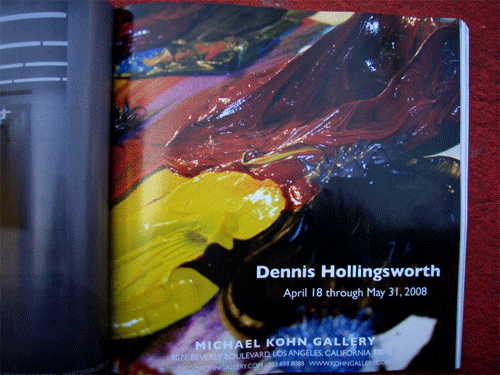
Finally, today's nonpolar world is not simply a result of the rise of other states and organizations or of the failures and follies of U.S. policy. It is also an inevitable consequence of globalization. Globalization has increased the volume, velocity, and importance of cross-border flows of just about everything, from drugs, e-mails, greenhouse gases, manufactured goods, and people to television and radio signals, viruses (virtual and real), and weapons.Globalization reinforces nonpolarity in two fundamental ways. First, many cross-border flows take place outside the control of governments and without their knowledge. As a result, globalization dilutes the influence of the major powers. Second, these same flows often strengthen the capacities of nonstate actors, such as energy exporters (who are experiencing a dramatic increase in wealth owing to transfers from importers), terrorists (who use the Internet to recruit and train, the international banking system to move resources, and the global transport system to move people), rogue states (who can exploit black and gray markets), and Fortune 500 firms (who quickly move personnel and investments). It is increasingly apparent that being the strongest state no longer means having a near monopoly on power. It is easier than ever before for individuals and groups to accumulate and project substantial power.
Still, even if nonpolarity was inevitable, its character is not. To paraphrase the international relations theorist Hedley Bull, global politics at any point is a mixture of anarchy and society. The question is the balance and the trend. A great deal can and should be done to shape a nonpolar world. Order will not just emerge. To the contrary, left to its own devices, a nonpolar world will become messier over time. Entropy dictates that systems consisting of a large number of actors tend toward greater randomness and disorder in the absence of external intervention.
...
April 15, 2008
Ahora
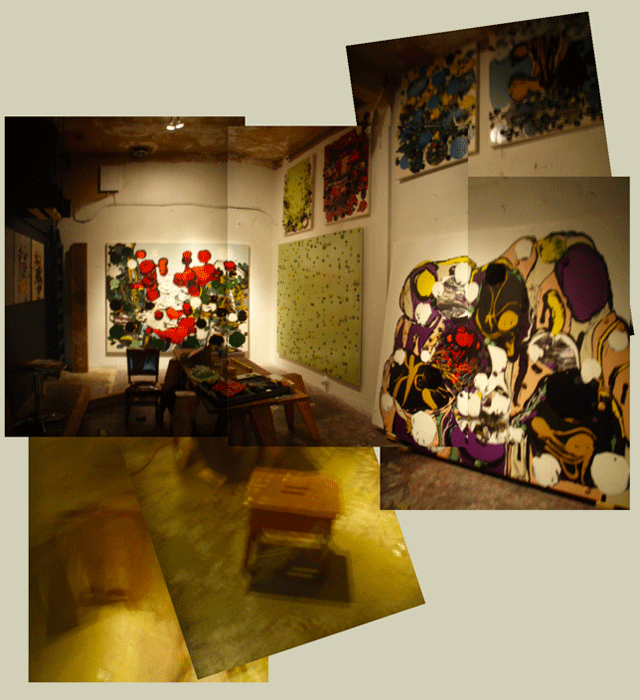
It's the last night in the studio with these guys. Tomorrow the lads from LA Packing and Crating are coming by to pick them all up.

Door's open. Music is up. A power bar and an orange for dinner. Fresh night air after a sweltering weekend. Some friends are dropping in. A new show is being set up next door. Hop Louie later for a nightcap. Savor the moment.
Very. Nice.
April 14, 2008
Announcements
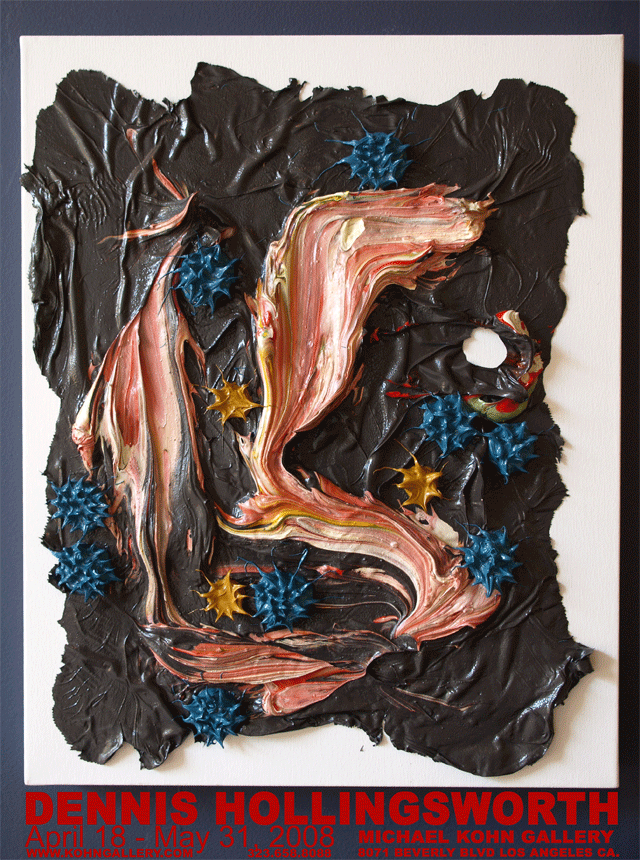
This was the second try.
(And still, I forget to list the date and time of the opening. Wuh. Glad I don't do this sort of thing for a living.)
The first one is here:
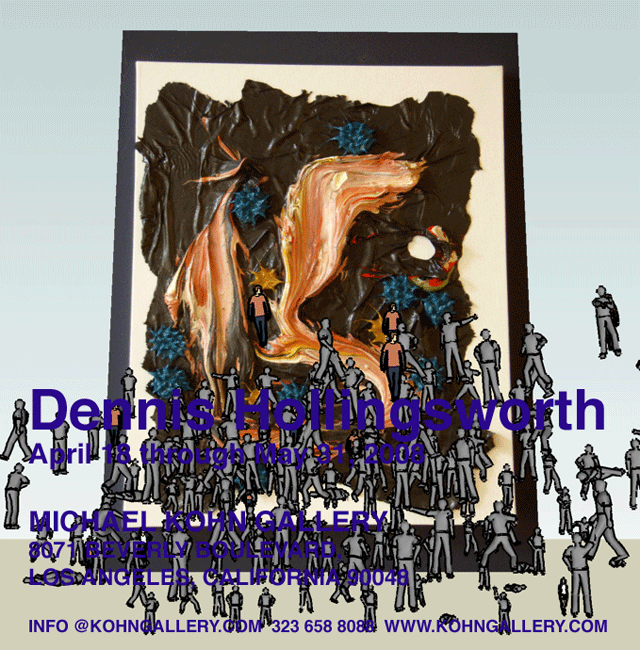
Sign me up.
The President's Analyst: The Cerebrum Communicator
I like to leaven my appreciation for techno-dystopianism with a good dose of techno-optimism:
My life has changed even more than most: I have information technology inside my body. I'm deaf, having had rubella (German measles) before I was born. Fortunately, the damage wasn't complete, so I was able to get by with hearing aids until 2001. Then my "good" ear abruptly quit working, for reasons that are still unknown. My hearing aids couldn't help me anymore, just as glasses can't help a blind person.It's a good article, and it gets better...Now I have a cochlear implant in each ear. At first glance, they look like behind-the-ear hearing aids -- but the technology is totally different. They digitize sound and broadcast the data through quarter-size radio transmitters. The transmitters are stuck to my head, behind my ears, using magnets.
The data are picked up by implants countersunk into my skull, which send the information to 16 electrodes in my inner ears. The electrodes trigger my auditory nerves with tiny, precisely targeted shocks, making them send sound information to my brain.
My implants don't aid my hearing. They create my hearing.
What I hear is, quite literally, a computer simulation of real sound. The day my first implant was activated in 2001, voices sounded bizarre; the radio might as well have been in Esperanto. That was because the software couldn't reproduce all the aspects of a normal auditory system. Still, I learned how to recognize consonants and vowels again by listening to books on tape. Now I can turn on the radio and hear it all but effortlessly.
In 2005, I got new software that made music sound brighter and clearer.
But there are other, much more intriguing possibilities. The human body hasn't changed in millions of years -- and that's a problem. Our bodies don't do very well with information technology. Screens are tiny and eye-straining, and keyboards injure fingers and wrists. Even people with young, nimble fingers can't type as fast as they can talk, let alone think.Sign me up.This mismatch between our Pentium chips and our Paleolithic bodies could be solved by physically integrating the two, the way I have cochlear implants inside me. Much as my implants make my brain "hear" sound, more advanced implants could one day evoke sensations of sight, touch and even feelings.
Or information could go the other way. For example, researchers at Brown University are implanting electrodes into the brains of people with paralyzed limbs to let them control computers and appliances with mental commands.
Consider where such technologies might go. Imagine someday being able to dictate e-mail with your thoughts, or thinking a Google search while walking down the street and "hearing" the answer read to you. Technologies like that could trigger changes in daily life even more profound than those unleashed by e-mail and the Web over the past 15 years.
Obviously, this scenario is an extrapolation from current technologies. But consider how far cochlear implants have come since 1978, when the first experimental multi-electrode device was surgically implanted in a patient. The device was so primitive that voices were barely intelligible, and the operation took eight hours. Compare that with my first implant surgery in 2001, which took 75 minutes. The second, in 2007, took 43 minutes. With both, I was listening to audiotapes within weeks.
Faster, pussycat.
April 10, 2008
Titles
Admin: This is an extension of an earlier post, a list of paintings that are bound for the April 18th show at Michael Kohn Gallery in Los Angeles. This list is partial at the time of this initial posting -04/10/08-, a few other works will be added in the next week's time.
All of the following images are scaled relative to one another.
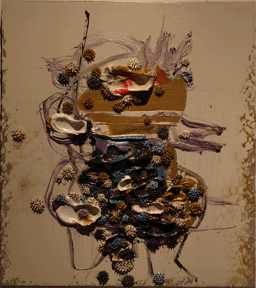
Precession
ww#285
2008
36"x32"
Oil on Linen over Wood Panel/Aluminum Stretcher
***
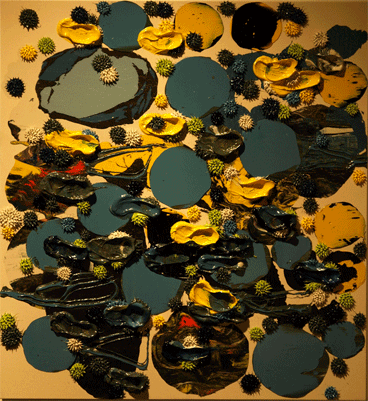
he will imagine true things
ww#286
2008
50"x46"
Oil on Canvas over Wood Panel
***
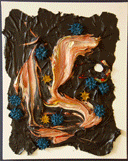
Strange Loops
ww#287
2008
20"x16"
Oil on canvas over Stretcher Bars
***
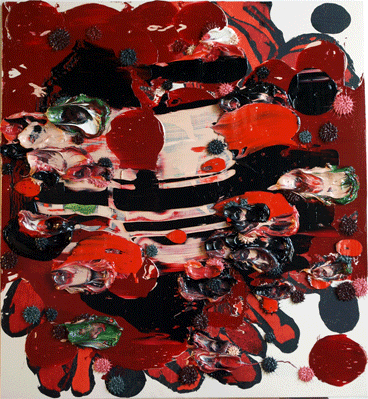
I Have Been Yours All Along
ww#288
2008
50"x46"
Oil on Canvas over Wood Panel
***

uncharted and even more boundless
ww#289
2008
50"x46"
Oil on Canvas over Wood Panel
***
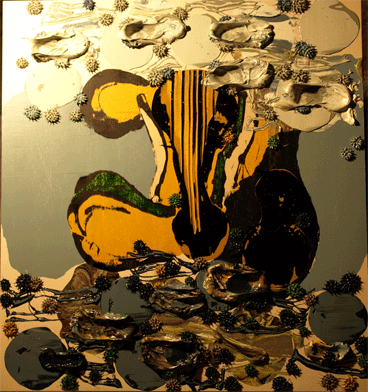
t = r x F
ww#290
2008
50"x46"
Oil on Canvas over Wood Panel
***
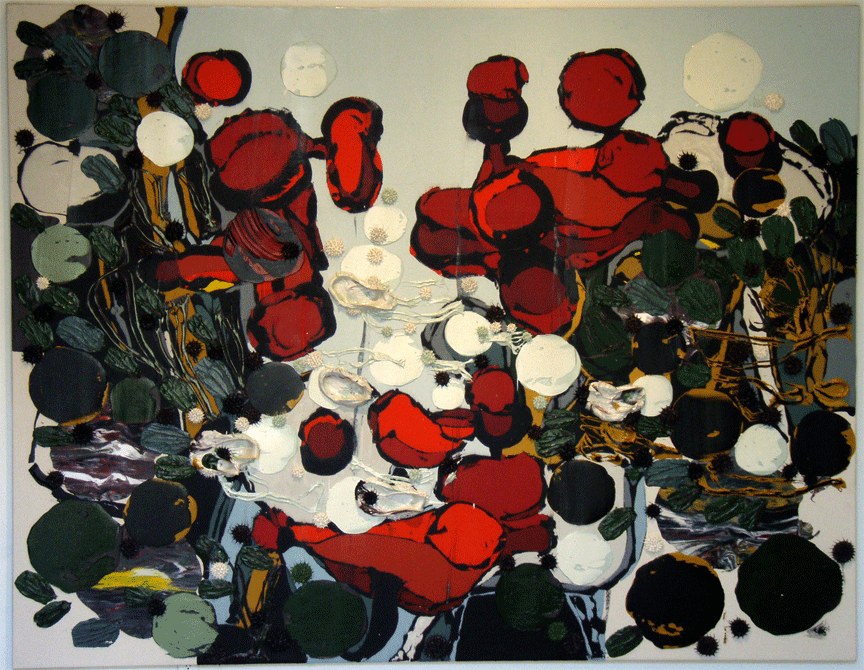
A Real Grimace
ww#291
2008
7' x 9'
Oil on Linen over Wood Panel/Aluminum Stretcher
***
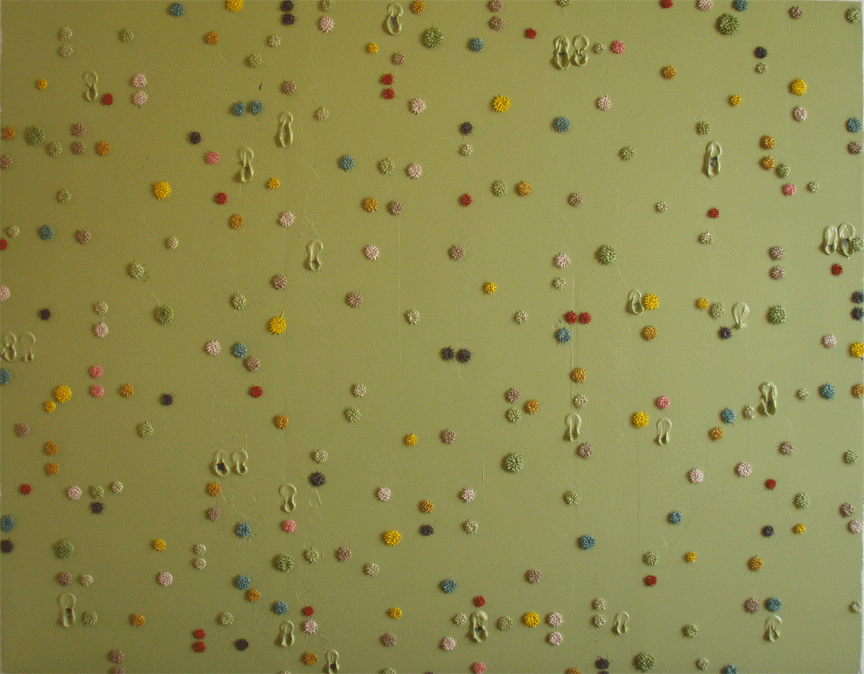
Return of the King of a Sceptered Isle
ww#292
2008
7' x 9'
Oil on Linen over Wood Panel/Aluminum Stretcher
***
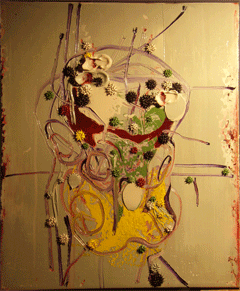
Dream of the Fisherman's Wife
ww#293
2008
36" x 30"
Oil on Linen over Wood Panel/Aluminum Stretcher
***
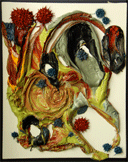
Carnitas
ww#294
2008
20" x 16"
Oil on canvas over Stretcher Bars
***
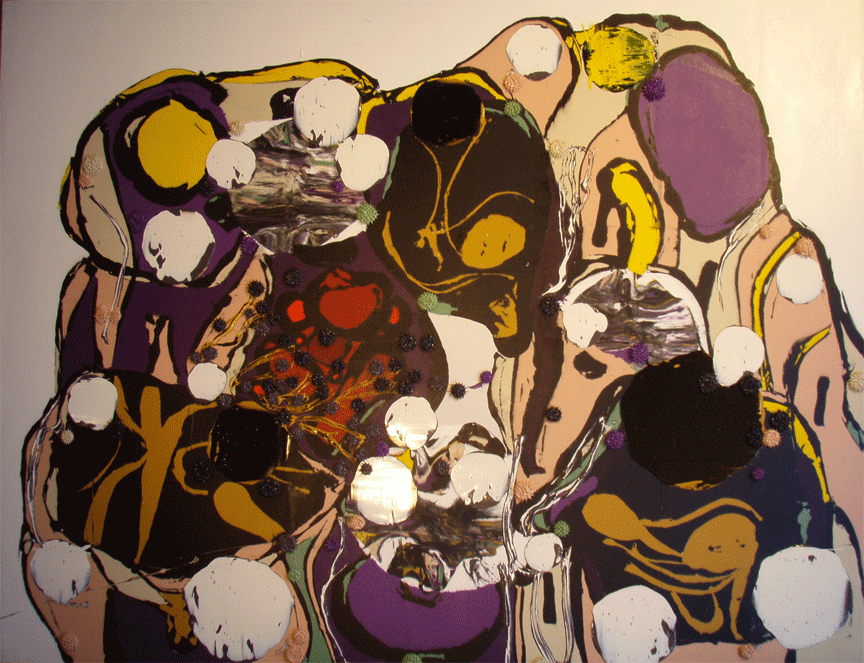
Deep6 Soutine
ww#295
2008
7' x 9'
Oil on Linen over Wood Panel/Aluminum Stretcher
***
(ww#296 is not in the MKG show)
***
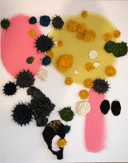
illuminated in a celestial glow
ww#297
2008
20"x16"
Oil on Canvas over Stretcher Bars
***
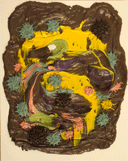
Big Luis
ww#298
2008
20"x16"
Oil on Canvas over Stretcher Bars
***
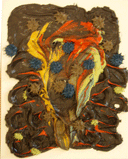
always be the hunter, never the rabbit
ww#299
2008
20"x16"
Oil on Canvas over Stretcher Bars
***
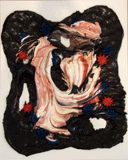
the law of the guerrillas
ww#300
2008
20"x16"
Oil on Canvas over Stretcher Bars
April 7, 2008
(Emphasis Mine)
1.Wertham shouldn't be mocked as a simpleton or censor, but he was rather prissy and uptight. As terrible as many comics were, they had a wildness and vitality that he couldn't appreciate. Comics had a raw, visceral power, reflecting the plebian underside of American culture. To put it another way, it's a racist and sexist culture that makes racist and sexist comics, not the other way around. And however wretched these comics were, they spoke to real psychological needs in children and teenagers. Kids need monsters and ghouls, supervillains and superfoes, as much as they need parents and teachers. The guardians of childhood face a difficult balancing act: They have to let kids give imaginative rein to their more destructive emotions while also protecting the young from genuinely harmful words and images. With his blunt language and crude simplifications, Fredric Wertham made this balancing act harder, not easier. If he had paid more attention to comic books, Wertham would have realized that he was following down the path of villains like Lex Luthor and Dr. Doom, who start off with good intentions only to become prisoners of their own blind arrogance.
2.
Sometimes journalists gave up promoting cataclysm and decided to cheerlead for it. In a Feb. 20, 2008, column, the Washington Post's Steven Pearlstein attacked Wall Street, saying "the best thing that could happen to our economy is for a dozen high-profile hedge funds to collapse; for investment banking to enter a long, deep freeze; for a major bank to fail."
Pearlstein ended his piece telling of the "voice in my head that keeps repeating that old '60s expression, 'Burn, baby, burn.' "
Some journalists are responsible and understand the problem. CNBC anchor Maria Bartiromo, on NBC's "Today" in early February, acknowledged the media's obsession with negative news: "We can talk ourselves into a recession, and that seems to be what we're doing right now, and that certainly begets more weakness."
She is correct. That's what the media have been doing since the end of the last recession.
And yet it was the Family that divorced itself from the stream of mankind and Heston's character that maintained its link. History seems to suggest that in order to achieve the greatest universality a man must appear to be alone, just as in order to attain the greatest provincialism, membership in a mob is necessary. Maybe we live as individuals so that our only final kinship is with all humanity and not simply with a family, tribe or sect.4.You are the best and the brightest. You, here in the fertile cradle of American academia, here in the castle of learning on the Charles River, you are the cream. But I submit that you, and your counterparts across the land, are the most socially conformed and politically silenced generation since Concord Bridge. And as long as you validate that ... and abide it ... you are - by your grandfathers' standards - cowards. ..
I know people care about the iWar. But not enough, given the circumstances. Not even close. Agree or disagree with the war, I don?t care - just give a fuck. Be able to find Basra on a map, know that the Tigris isn?t some sort of unholy crossbreed found at the San Diego Zoo, try to figure out the difference between a Sunni and a Shi?a even if it conplexes and perfuses your mind beyond repair. I wish I could issue some loud, righteous proclamation here about the repercussions of such continued resounding American apathy, but who are we kidding? The warrior caste is simply too small nowadays, and too proud. There will be no reckoning for all of this. We?ll fight the fights not because we necessarily want to, but because no one else will. We were bred to protect. Even if we?re protecting nothing more than an isolationistic yawn prefacing the continental slumber history demands occur after protracted warfare.
The long-predicted national debate about national security policy has yet to occur. Essentially tactical issues have overwhelmed the most important challenge a new administration will confront: how to distill a new international order from three simultaneous revolutions occurring around the globe: (a) the transformation of the traditional state system of Europe; (b) the radical Islamist challenge to historic notions of sovereignty; and (c) the drift of the center of gravity of international affairs from the Atlantic to the Pacific and Indian Oceans......No previous generation has had to deal with different revolutions occurring simultaneously in separate parts of the world. The quest for a single, all-inclusive remedy is chimerical. In a world in which the sole superpower is a proponent of the prerogatives of the traditional nation-state, where Europe is stuck in halfway status, where the Middle East does not fit the nation-state model and faces a religiously motivated revolution, and where the nations of South and East Asia still practice the balance of power, what is the nature of the international order that can accommodate these different perspectives? What should be the role of Russia, which is affirming a notion of sovereignty comparable to America's and a strategic concept of the balance of power similar to Asia's? Are existing international organizations adequate for this purpose? What goals can America realistically set for itself and the world community? Is the internal transformation of major countries an attainable goal? What objectives must be sought in concert, and what are the extreme circumstances that would justify unilateral action?
This is the kind of debate we need, not focus-group-driven slogans designed to grab headlines.
Miller is particularly troubled by the financial situation in higher education, especially a financial aid system that he considers to be a byzantine mess that, especially as tuitions continue to soar, is ultimately failing to fulfill its primary purpose: expanding access to a college education to those who need it most. And not only do college officials show no serious signs of trying to fix the system?s flaws, he says, but Congress and others keep passing laws that just pour more money into it and even add to the complexity.Part of the reason they do that, Miller argues, is because they believe college is such a valuable asset for individuals and for society. And they think that, in part, because of the widely embraced assertion that college is worth a million dollars in the bank. If a degree has that much value, how can we as a society not do everything possible to make sure everyone has a shot at the golden ring?
But what if the college premium doesn?t exist, or is greatly exaggerated? If a college degree isn?t worth as much as the conventional wisdom assumes, is it possible that the money the country keeps pouring into the current financial aid system isn?t wise? That taxpayer acceptance of the ever-rising price of higher education, patience that already wearing thin, would evaporate? And that that combination of factors would finally force college leaders and policy makers and others to get serious about confronting the problems?
April 6, 2008
Through the Garden, We Left for the Mountains
"In 1938, twenty-one-year-old Fransisco P?rez L?pez, born in Spain and raised in France and Algeria, joined the International Brigades to fight the Nationalist armies of Franco and became part of the bloodiest guerilla war in Spanish history..." So introduces the author in the front flap of Dark and Bloody Ground, A Guerilla Diary of the Spanish Civil War.
Here's the end of the chapter entitled "Escape", (pages 160-163):When night fell the young one went out back to watch for the two men, who were to meet her a the end of the garden. They came in and we shook hands. We sat down at the end of the table and while we ate I told them who I was, what I had done during the war, how I had been a prisoner and escaped. Then, I unfolded my plan.
One man alone had little chance of getting across country occupied by the enemy. He could not cover himself from ambush by Civil Guardsmen when he went to fill the canteen at a spring. It was the same when he went up to a farm to ask for food and didn't know whether he would find friends or enemies. And he couldn't attack; and to get through enemies you had to attack without cease. A man who was running away was a dead man. You must always be the hunter, never the rabbit. Only as guerillas could we make it to the frontier, and for that we had to gather a band, as we were starting to do this evening, from all the Republicans hidden in the villages or mountains who wanted to join us to continue the fight and find liberty or death. But all those who wanted to come along had to obey me. They had to follow the law of the guerillas: no pity for the mercenaries, the Civil Guard of army officers, for if a guerilla fell into their hands it would be torture and death. But the guerillas must respect women, children and old people, and if they met girls in the mountains, they must never touch them -- that was sacred. If you had to kill a civilian, it must be because he was a spy, a person who had others arrested or a Falangist leader who had brought Republicans to trial and imprisonment. Then it would be his turn to be condemned and punished. But even then only with the accord of all, like a tribunal marked with the great R of the Republic. As for money found on enemy corpses, I alone would guard it. It would be returned in full to the poor peasants who helped us.I told them how I had commanded a group of guerillas in the International Brigade, how I had learned by actual fighting the special tactics of this kind of combat. It was because of my experience that I would give the orders and by following them they would save their own lives and do the most possible damage to the enemy.
Both men agreed. They told me what they had done in the war. Vicente, the younger, medium in build and rather beefy, had served as an artilleryman in the Durruti Column. He didn't say much but listened with eyes moving restlessly in all directions. The other, Luis, talked on and on using his tobacco-stained hands as much as his mouth. He was a big, quick man and had been, he said, political commissar in Lister's corps. Vicente was an anarchist.
After supper I took them upstairs. Big Luis was surprised by the quality of my arsenal. He ran his fingers along the dagger and admired the way it cut like a razor. Vicente only had an old five-chamber revolver which he said he couldn't use very well. He was good with with all other weapons including knife and dagger. But he wasn't good at the revolver. Big Luis was armed with a hunting rifle and two hundred cartridges. It was behind the garden gate with his ammunition belt. He admitted he too was a bad shot with the revolver.
I explained the orders to them, cries for rallying in case of surprise, cries of attack, cries of command. We talked until one in the morning. They thought we would leave at night, but I decided to take the mountains in full daylight after dinner. We went to bed and slept till ten.
I got back into my Francoist uniform with the Red Cross armband. Dagger in its pants pocket, knife and grenade in the packet pockets, another grenade and canteen in new pockets sewn into the rucksack. Then a Mauser and two clips. My rucksack was packed with the pharmacy, bread and sausages.
Vicente jand Luis wore dark brown peasant corduroy, Vicente's rucksack contained a can of lard, a large load of bread, three large sausages, a big chunk of dried ham, big box of salt, pepper, a small bottle of vinegar, a bottle of wine, three packages of cigarettes even though he smoked little. Big Luis had another large loaf, another big chunk of dried ham, some sausages, two chocolate bars, shaving soap, a razor with five blades and two towels. I said no fruit; to protect your movements you had to load yourself down as little as possible. I gave Luis the other Mauser with a full clip and a grenade. He had an ordinary but very large knife. He also had his pockets full of tobacco and cigarettes, and a pipe hung at his belt. On his shoulder was his hunting rifle, at his waist the ammunition belt, and, slung on a bandolier, a two-liter canteen of wine.
When our preparations were finished, we went down to the kitchen. We ate and drank well. We smoked a last cigarette. I gave Vicente's revolver to the old woman telling to hide it; one day she might have to use it. About three o'clock, going out through the garden, we left for the mountains.
April 5, 2008
Vitrine
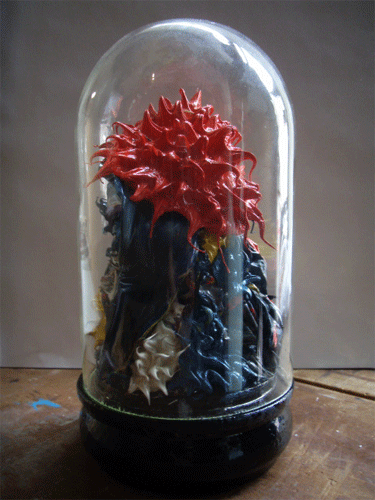
I had a few peels on hand, and the Chinese curio shop around the corner has a few vitrines.
It was a little bit tricky. I had to build it in stages since the paint in the interior was molten enough to shift. The whole thing might just slag to the bottom over time, butI'm betting that it won't.
Armature, that's what might be needed.
Next time, I might just slap the peels right on the kitch cork scenes and use them for structure.
Funny, that bell glass. Deep6 Soutine, indeed.
Ahora Last Night
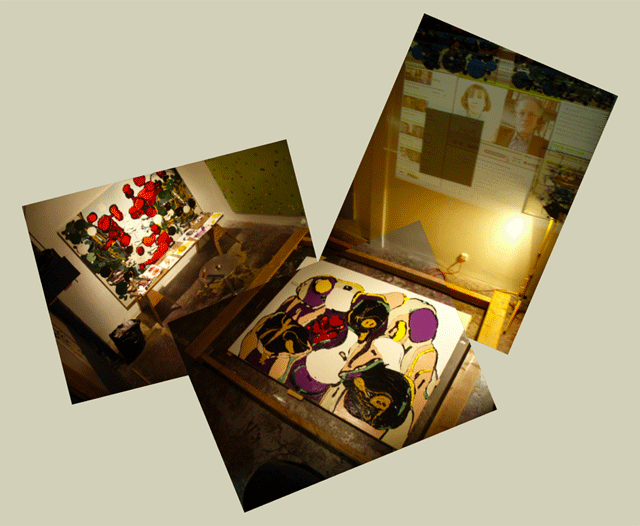
At this point I was about to shear off the mass of paint to reveal the "drawing " below. You can see the three holes left blank so I can later drop Jupiter on them. Shearing off the paint and dropping them in a way so as to pull the colors into striated lines makes me think of bar codes and these Jupiters as a kind of encoding of the information that rendered the drawing below.
(On screen: Paul Berman talking about the legacy of '68 with Heather Hurlburt. That's BloggingheadsTV, an interesting site.)
A detail of the Jupiter drop:
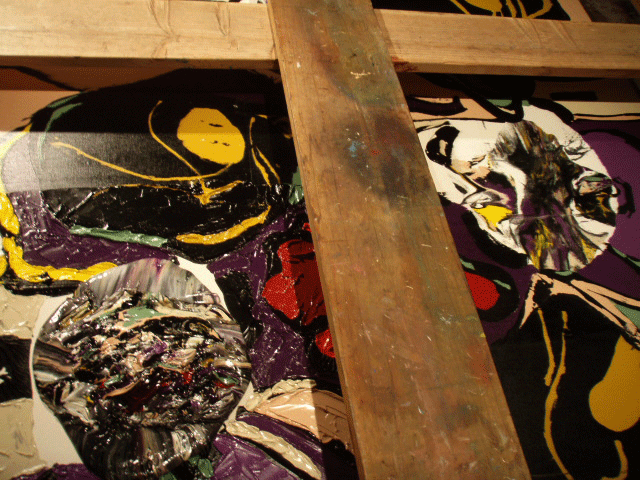
Here it is after the shear:
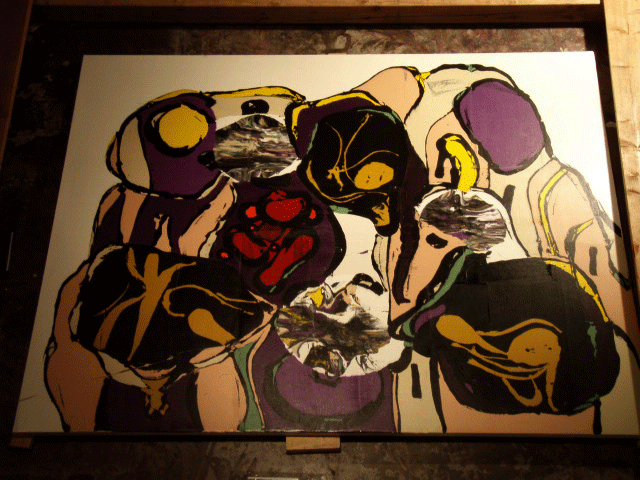
I'm about halfway done.
Work on Paper
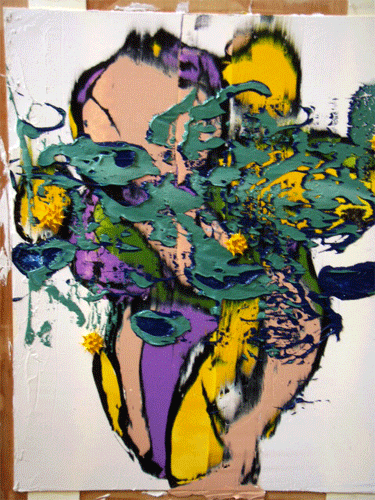
A work on paper left unfinished over a year ago, although there's little I would do to alter it now. I've kept it nearby, always looking at it, and now it's a color story for the current painting.
A little context for scale after the jump...
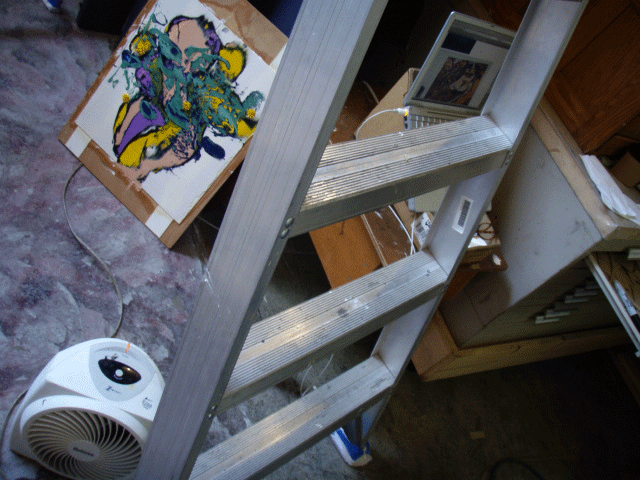
April 4, 2008
April 3, 2008
April 2, 2008
April 1, 2008
LA DriveBy
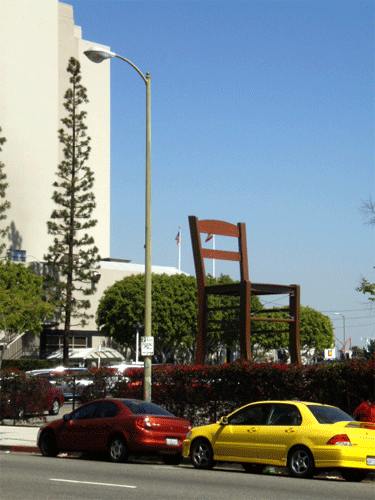
Robert Therrien off Hill Street between 19th and 20th.
the movie called You
Back in the day between undergrad and grad school, while I was apprenticing with architecture firms I was painting at night and on weekends. I was reading E. H. Gombrich and Rudolf Arnheim, thinkers who made a huge impression on me and unfortunately haven't been incorporated into the dialog in the art world at large as much as I think they should be. Here's the tail end of an article in today's NYTimes which is a testament to Gombrich and Arnheim's enduring relevance in our art world and beyond:
The mechanisms that succeed in seizing our sightline fall into two basic classes: bottom up and top down. Bottom-up attentiveness originates with the stimulus, with something in our visual field that is the optical equivalent of a shout: a wildly waving hand, a bright red object against a green field. Bottom-up stimuli seem to head straight for the brainstem and are almost impossible to ignore, said Nancy Kanwisher, a vision researcher at M.I.T., and thus they are popular in Internet ads.I would identify the top down aspect with what we call the art world dialogue, and the bottom up with the visual studies pioneered by the likes of Gombrich and Arnheim.Top-down attentiveness, by comparison, is a volitional act, the decision by the viewer that an item, even in the absence of flapping parts or strobe lights, is nonetheless a sight to behold. When you are looking for a specific object ? say, your black suitcase on a moving baggage carousel occupied largely by black suitcases ? you apply a top-down approach, the bouncing searchlights configured to specific parameters, like a smallish, scuffed black suitcase with one broken wheel. Volitional attentiveness is much trickier to study than is a simple response to a stimulus, yet scientists have made progress through improved brain-scanning technology and the ability to measure the firing patterns of specific neurons or the synchronized firing of clusters of brain cells.
Recent studies with both macaques and humans indicate that attentiveness crackles through the brain along vast, multifocal, transcortical loops, leaping to life in regions at the back of the brain, in the primary visual cortex that engages with the world, proceeding forward into frontal lobes where higher cognitive analysis occurs, and then doubling back to the primary visual centers. En route, the initial signal is amplified, italicized and annotated, and so persuasively that the boosted signal seems to emanate from the object itself. The enhancer effect explains why, if you?ve ever looked at a crowd photo and had somebody point out the face of, say, a young Franklin Roosevelt or George Clooney in the throng, the celebrity?s image will leap out at you thereafter as though lighted from behind.To say that one or the other is superior would be missing the ultimate point, that we need both and we need both to interact dynamically. Fluidity might be the kind of thing we need in our dialog in the arts. Make a paradigm, break a paradigm, make another paradigm... fluidity. Keep it moving, people.Whether lured into attentiveness by a bottom-up or top-down mechanism, scientists said, the results of change blindness studies and other experiments strongly suggest that the visual system can focus on only one or very few objects at a time, and that anything lying outside a given moment?s cone of interest gets short shrift. The brain, it seems, is a master at filling gaps and making do, of compiling a cohesive portrait of reality based on a flickering view.
?Our spotlight of attention is grabbing objects at such a fast rate that introspectively it feels like you?re recognizing many things at once,? Dr. Wolfe said. ?But the reality is that you are only accurately representing the state of one or a few objects at any given moment.? As for the rest of our visual experience, he said, it has been aptly called ?a grand illusion.? Sit back, relax and enjoy the movie called You.And to speak of the beyond, here's a political implication mapped by a psych/politico blogger by the name of Shrinkwrapped. Unfortunately the top down mechanisms dominating much of our fellow art worlders won't admit this connection easily.
